Christian Häne
Repurposing 2D Diffusion Models with Gaussian Atlas for 3D Generation
Mar 20, 2025Abstract:Recent advances in text-to-image diffusion models have been driven by the increasing availability of paired 2D data. However, the development of 3D diffusion models has been hindered by the scarcity of high-quality 3D data, resulting in less competitive performance compared to their 2D counterparts. To address this challenge, we propose repurposing pre-trained 2D diffusion models for 3D object generation. We introduce Gaussian Atlas, a novel representation that utilizes dense 2D grids, enabling the fine-tuning of 2D diffusion models to generate 3D Gaussians. Our approach demonstrates successful transfer learning from a pre-trained 2D diffusion model to a 2D manifold flattened from 3D structures. To support model training, we compile GaussianVerse, a large-scale dataset comprising 205K high-quality 3D Gaussian fittings of various 3D objects. Our experimental results show that text-to-image diffusion models can be effectively adapted for 3D content generation, bridging the gap between 2D and 3D modeling.
Rethinking Video-Text Understanding: Retrieval from Counterfactually Augmented Data
Jul 18, 2024Abstract:Recent video-text foundation models have demonstrated strong performance on a wide variety of downstream video understanding tasks. Can these video-text models genuinely understand the contents of natural videos? Standard video-text evaluations could be misleading as many questions can be inferred merely from the objects and contexts in a single frame or biases inherent in the datasets. In this paper, we aim to better assess the capabilities of current video-text models and understand their limitations. We propose a novel evaluation task for video-text understanding, namely retrieval from counterfactually augmented data (RCAD), and a new Feint6K dataset. To succeed on our new evaluation task, models must derive a comprehensive understanding of the video from cross-frame reasoning. Analyses show that previous video-text foundation models can be easily fooled by counterfactually augmented data and are far behind human-level performance. In order to narrow the gap between video-text models and human performance on RCAD, we identify a key limitation of current contrastive approaches on video-text data and introduce LLM-teacher, a more effective approach to learn action semantics by leveraging knowledge obtained from a pretrained large language model. Experiments and analyses show that our approach successfully learn more discriminative action embeddings and improves results on Feint6K when applied to multiple video-text models. Our Feint6K dataset and project page is available at https://feint6k.github.io.
CHOSEN: Contrastive Hypothesis Selection for Multi-View Depth Refinement
Apr 02, 2024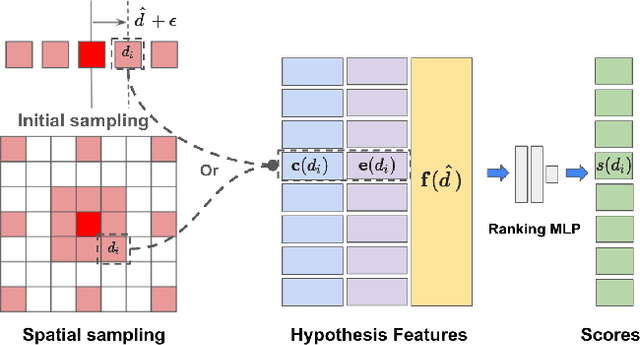
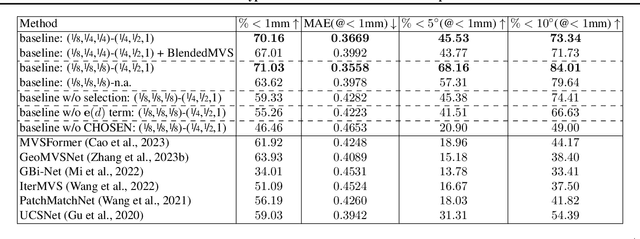
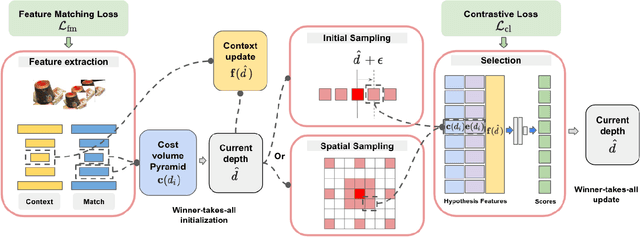

Abstract:We propose CHOSEN, a simple yet flexible, robust and effective multi-view depth refinement framework. It can be employed in any existing multi-view stereo pipeline, with straightforward generalization capability for different multi-view capture systems such as camera relative positioning and lenses. Given an initial depth estimation, CHOSEN iteratively re-samples and selects the best hypotheses, and automatically adapts to different metric or intrinsic scales determined by the capture system. The key to our approach is the application of contrastive learning in an appropriate solution space and a carefully designed hypothesis feature, based on which positive and negative hypotheses can be effectively distinguished. Integrated in a simple baseline multi-view stereo pipeline, CHOSEN delivers impressive quality in terms of depth and normal accuracy compared to many current deep learning based multi-view stereo pipelines.
OmniSyn: Synthesizing 360 Videos with Wide-baseline Panoramas
Feb 22, 2022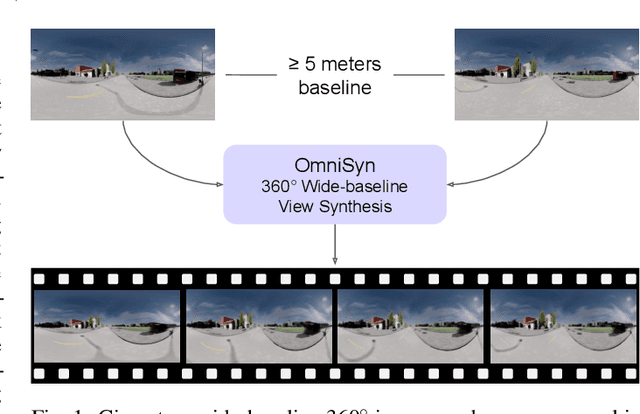

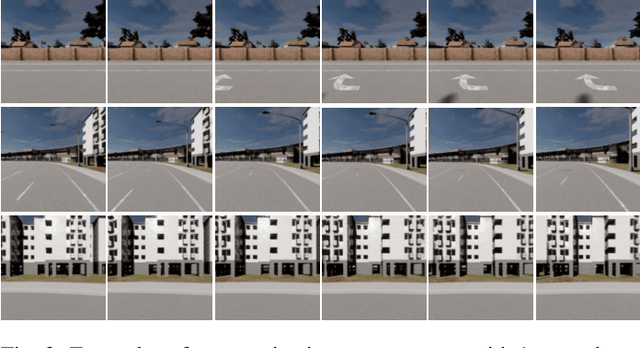
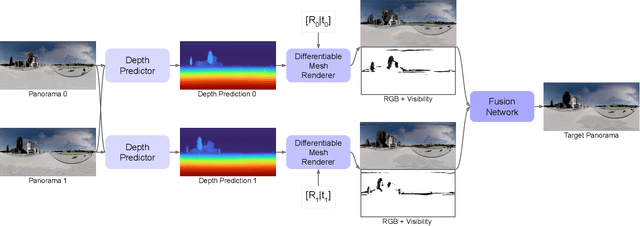
Abstract:Immersive maps such as Google Street View and Bing Streetside provide true-to-life views with a massive collection of panoramas. However, these panoramas are only available at sparse intervals along the path they are taken, resulting in visual discontinuities during navigation. Prior art in view synthesis is usually built upon a set of perspective images, a pair of stereoscopic images, or a monocular image, but barely examines wide-baseline panoramas, which are widely adopted in commercial platforms to optimize bandwidth and storage usage. In this paper, we leverage the unique characteristics of wide-baseline panoramas and present OmniSyn, a novel pipeline for 360{\deg} view synthesis between wide-baseline panoramas. OmniSyn predicts omnidirectional depth maps using a spherical cost volume and a monocular skip connection, renders meshes in 360{\deg} images, and synthesizes intermediate views with a fusion network. We demonstrate the effectiveness of OmniSyn via comprehensive experimental results including comparison with the state-of-the-art methods on CARLA and Matterport datasets, ablation studies, and generalization studies on street views. We envision our work may inspire future research for this unheeded real-world task and eventually produce a smoother experience for navigating immersive maps.
HITNet: Hierarchical Iterative Tile Refinement Network for Real-time Stereo Matching
Jul 23, 2020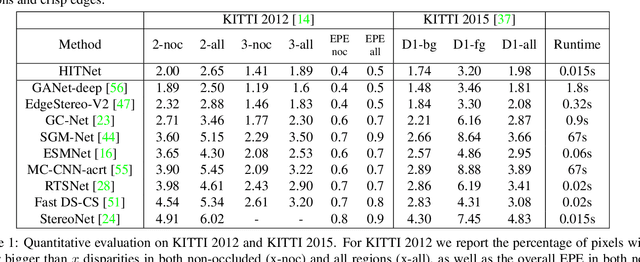
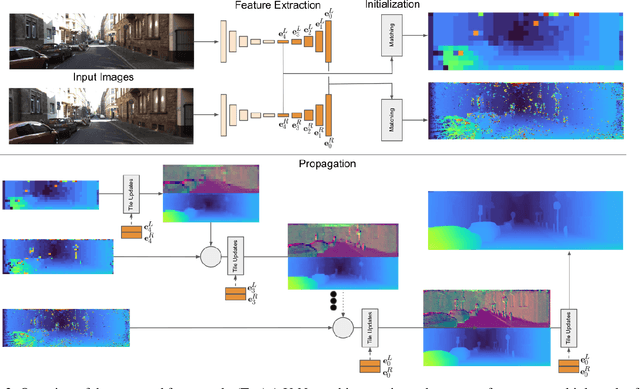

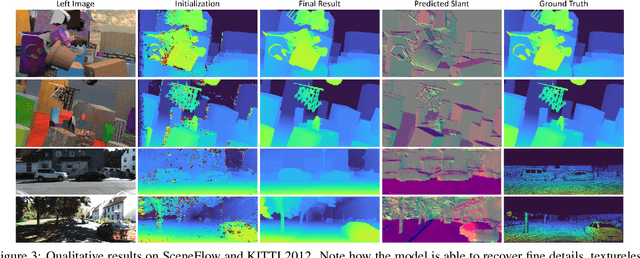
Abstract:This paper presents HITNet, a novel neural network architecture for real-time stereo matching. Contrary to many recent neural network approaches that operate on a full cost volume and rely on 3D convolutions, our approach does not explicitly build a volume and instead relies on a fast multi-resolution initialization step, differentiable 2D geometric propagation and warping mechanisms to infer disparity hypotheses. To achieve a high level of accuracy, our network not only geometrically reasons about disparities but also infers slanted plane hypotheses allowing to more accurately perform geometric warping and upsampling operations. Our architecture is inherently multi-resolution allowing the propagation of information at different levels. Multiple experiments prove the effectiveness of the proposed approach at a fraction of the computation required by recent state-of-the-art methods. At time of writing, HITNet ranks 1st-3rd on all the metrics published on the ETH3D website for two view stereo and ranks 1st on the popular KITTI 2012 and 2015 benchmarks among the published methods faster than 100ms.
Du$^2$Net: Learning Depth Estimation from Dual-Cameras and Dual-Pixels
Mar 31, 2020



Abstract:Computational stereo has reached a high level of accuracy, but degrades in the presence of occlusions, repeated textures, and correspondence errors along edges. We present a novel approach based on neural networks for depth estimation that combines stereo from dual cameras with stereo from a dual-pixel sensor, which is increasingly common on consumer cameras. Our network uses a novel architecture to fuse these two sources of information and can overcome the above-mentioned limitations of pure binocular stereo matching. Our method provides a dense depth map with sharp edges, which is crucial for computational photography applications like synthetic shallow-depth-of-field or 3D Photos. Additionally, we avoid the inherent ambiguity due to the aperture problem in stereo cameras by designing the stereo baseline to be orthogonal to the dual-pixel baseline. We present experiments and comparisons with state-of-the-art approaches to show that our method offers a substantial improvement over previous works.
Cost-Sensitive Active Learning for Intracranial Hemorrhage Detection
Sep 08, 2018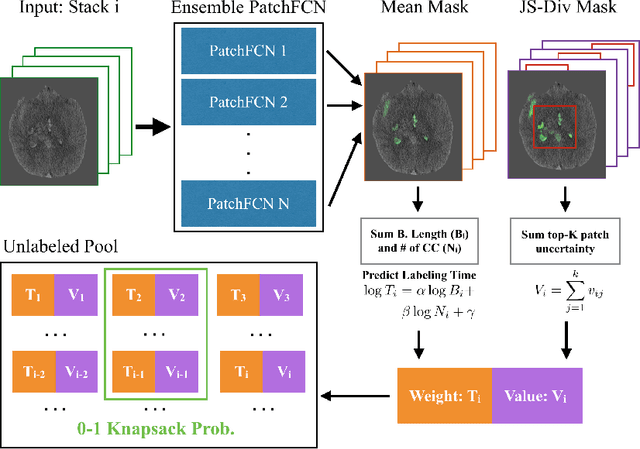

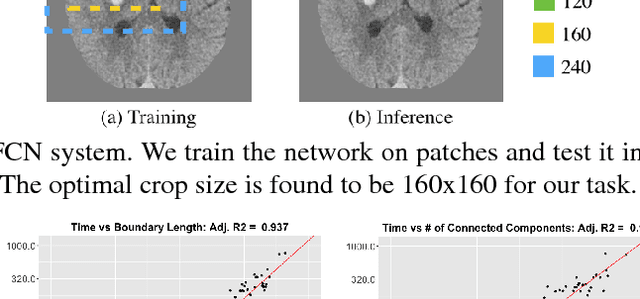
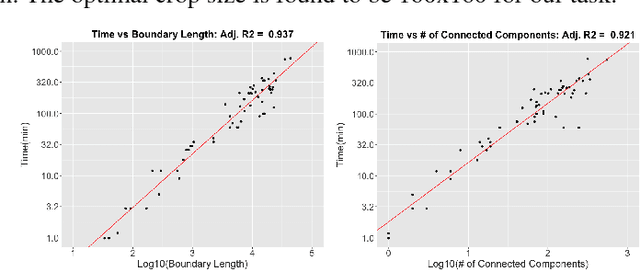
Abstract:Deep learning for clinical applications is subject to stringent performance requirements, which raises a need for large labeled datasets. However, the enormous cost of labeling medical data makes this challenging. In this paper, we build a cost-sensitive active learning system for the problem of intracranial hemorrhage detection and segmentation on head computed tomography (CT). We show that our ensemble method compares favorably with the state-of-the-art, while running faster and using less memory. Moreover, our experiments are done using a substantially larger dataset than earlier papers on this topic. Since the labeling time could vary tremendously across examples, we model the labeling time and optimize the return on investment. We validate this idea by core-set selection on our large labeled dataset and by growing it with data from the wild.
PatchFCN for Intracranial Hemorrhage Detection
Jun 08, 2018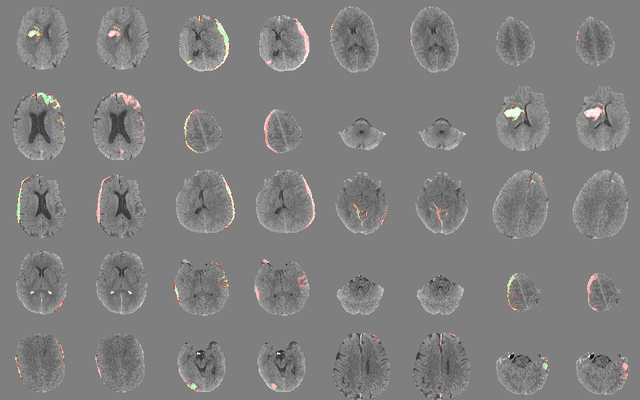
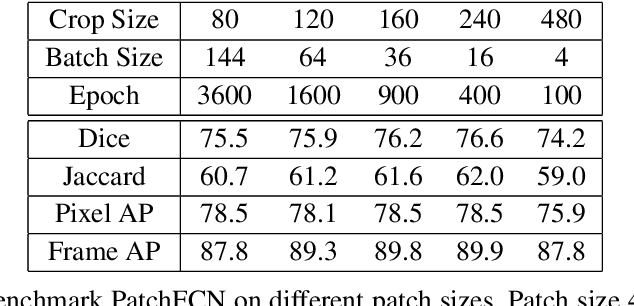
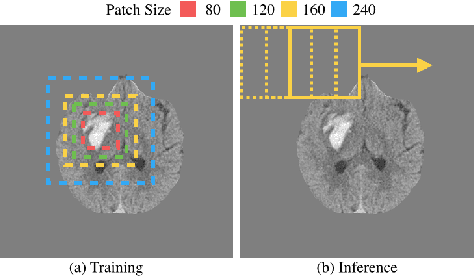

Abstract:This paper studies the problem of detecting acute intracranial hemorrhage on head computed tomography (CT) scans. We formulate it as a pixel-wise labeling task of the frames that constitute a single head scan. The standard approach for this task is the fully convolutional network (FCN) which runs on the whole image at both training and test time. We propose a patch-based approach that controls the amount of context available to the FCN, based on the observation that when radiologists are interpreting CT scans, their judgment depends primarily on local cues and does not require the whole image context. To develop and validate the system, we collected a pixel-wise labeled dataset of 591 scans that covers a wide range of hemorrhage types and imaging conditions in the real world. We show that no pretraining from natural images is needed. By aggregating the pixel-wise labeling, our system is able to make region-level, frame-level, and stack-level decisions. Our final system approaches an expert radiologist performance with a high average precision (AP) of 96.5 +/- 1.3 % for hemorrhage classification on stack level while running at 23ms per frame
Hierarchical Surface Prediction for 3D Object Reconstruction
Nov 06, 2017

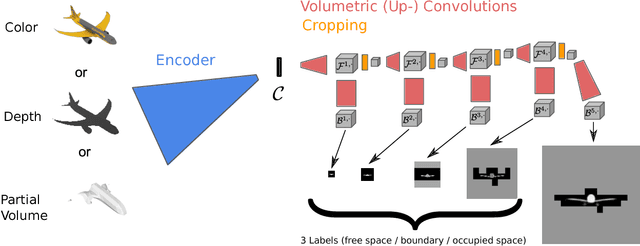
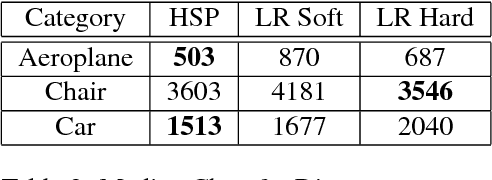
Abstract:Recently, Convolutional Neural Networks have shown promising results for 3D geometry prediction. They can make predictions from very little input data such as a single color image. A major limitation of such approaches is that they only predict a coarse resolution voxel grid, which does not capture the surface of the objects well. We propose a general framework, called hierarchical surface prediction (HSP), which facilitates prediction of high resolution voxel grids. The main insight is that it is sufficient to predict high resolution voxels around the predicted surfaces. The exterior and interior of the objects can be represented with coarse resolution voxels. Our approach is not dependent on a specific input type. We show results for geometry prediction from color images, depth images and shape completion from partial voxel grids. Our analysis shows that our high resolution predictions are more accurate than low resolution predictions.
Learning a Multi-View Stereo Machine
Aug 17, 2017



Abstract:We present a learnt system for multi-view stereopsis. In contrast to recent learning based methods for 3D reconstruction, we leverage the underlying 3D geometry of the problem through feature projection and unprojection along viewing rays. By formulating these operations in a differentiable manner, we are able to learn the system end-to-end for the task of metric 3D reconstruction. End-to-end learning allows us to jointly reason about shape priors while conforming geometric constraints, enabling reconstruction from much fewer images (even a single image) than required by classical approaches as well as completion of unseen surfaces. We thoroughly evaluate our approach on the ShapeNet dataset and demonstrate the benefits over classical approaches as well as recent learning based methods.
 Add to Chrome
Add to Chrome Add to Firefox
Add to Firefox Add to Edge
Add to Edge